The field of dental imaging technology has evolved over the years. Digital imaging has now replaced traditional film-based radiography, which was once the gold standard in dentistry.
One of the most significant advancements in this transition is the use of phosphor plate scanners. These devices combine the advantages of film imaging with the ease and speed of digital technology.
For dental professionals, embracing phosphor plate scanners is not only about upgrading equipment. The primary goals are to improve diagnostic accuracy, enhance patient experience, and optimize workflow efficiency.
If your practice still uses old radiographic techniques, now is the time to consider a phosphor scanner. This can help improve your dental practice.
Understanding Phosphor Plate Scanners
Phosphor plate scanners play a crucial role in modern dental imaging technology. It bridges the gap between traditional film-based X-rays and digital sensor systems.
These devices utilize phosphor plates to capture high-resolution images and process them digitally for precise diagnostics. Their ability to make images clearer and maintain a smooth workflow is important. This makes them a key tool in today’s dental practices.
What Is a Phosphor Plate?
A phosphor plate is a flexible, reusable imaging plate coated with photostimulable phosphor crystals. These plates work similarly to traditional film, but they can be erased and reused multiple times.
When exposed to X-ray radiation, the phosphor crystals capture and store the image. They process it digitally using a phosphor plate scanner.
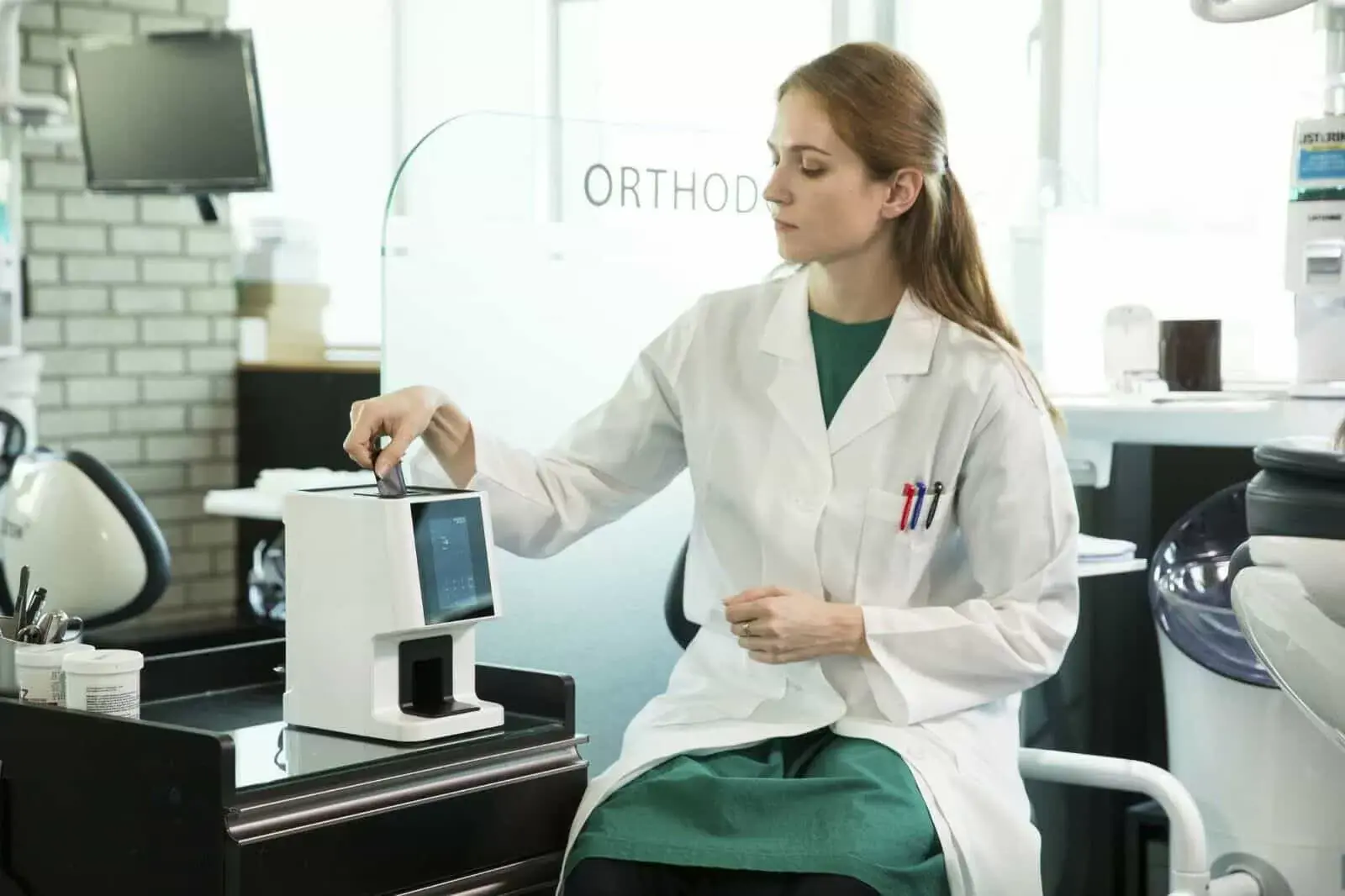
Advantages of Phosphor Plates
Many dental professionals prefer phosphor plates over direct digital sensors due to their versatility and cost-effectiveness. Phosphor plates offer a blend of traditional film and digital imaging, making them a popular choice for evolving practices.
Some of the key benefits of phosphor plates include:
- Flexible and comfortable for patients: Phosphor plates are thin and flexible. Unlike rigid digital sensors, they are more comfortable in a patient’s mouth.
- Reusable and cost-effective: Phosphor plates can be used many times. This helps lower long-term costs compared to disposable film.
- High-resolution imaging: These plates provide superior image quality, allowing for precise diagnoses
- Compatibility with existing X-ray equipment: Many phosphor plate scanners can be integrated into existing dental practices without requiring extensive modifications
How Phosphor Plate Scanners Work
Understanding the operation of phosphor plate scanners is crucial for optimizing their use in dental practices. These scanners function through a precise process that converts X-ray exposures into high-quality digital images. Their efficiency and accuracy have made them an essential tool in modern dental imaging technology.
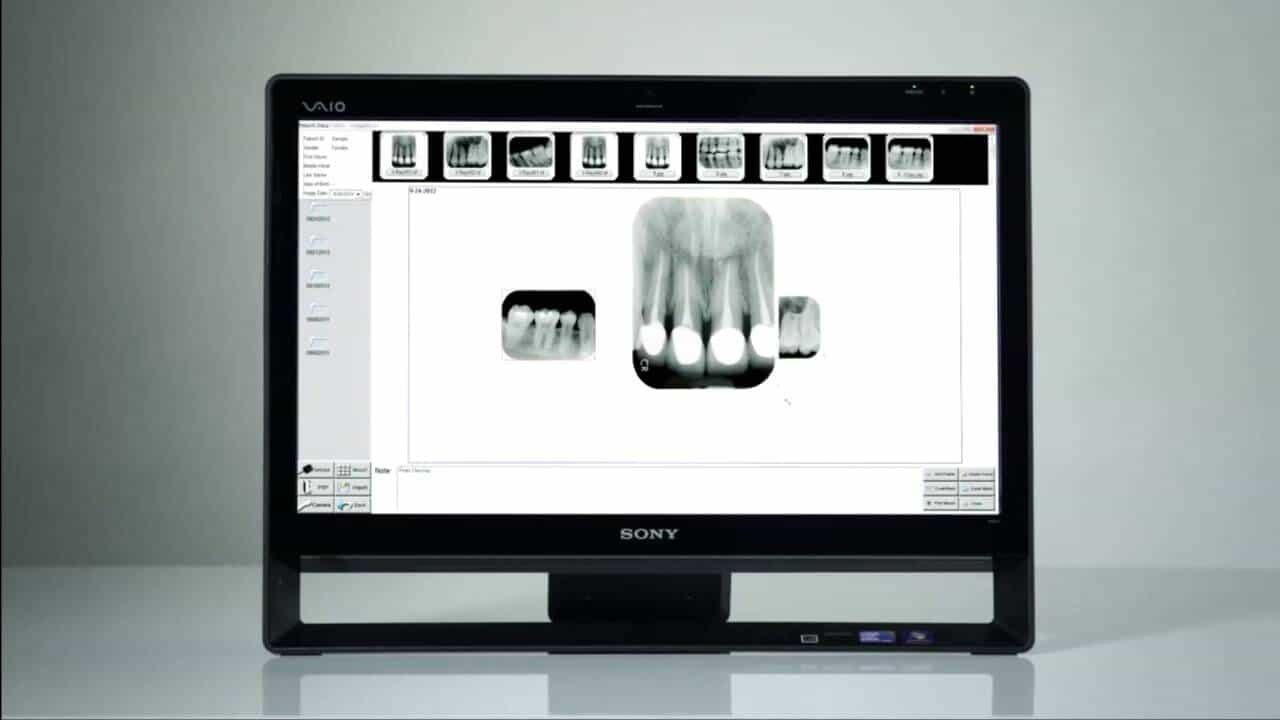
Image Capture
When exposed, the phosphor plate absorbs X-ray photons. It creates a hidden image by storing energy in its phosphor crystals. The stored energy remains trapped in the phosphor layer until scanning releases it.
This process allows the phosphor plate to work like traditional X-ray film and is also reusable in digital form.
The phosphor material used in these plates is sensitive to X-rays, ensuring that we capture even the smallest details with precision. Once exposed, the plate retains the image until processed, making it an efficient and reliable tool for dental diagnostics.
Scanning Process
An operator puts the plate into a phosphor plate scanner. A precise laser beam stimulates the plate one step at a time, causing the trapped energy to emit visible light.
A high-precision photodetector captures this emitted light and converts it into an electrical signal. The scanner processes the signal into a clear digital image. You can analyze, improve, and save this image for later review.
Image Display and Storage
The digital image appears on a computer screen, which can be analyzed, enhanced, and stored electronically. Advanced software tools allow dental professionals to manipulate the images by adjusting the following:
- Brightness
- Contrast
Professionals can also zoom in on specific areas for more precise diagnostics. You can easily share these digital images with specialists. They can also be stored in patient records for long-term tracking and comparison. Plate Erasure and Reuse
After scanning, the phosphor plate is erased using an intense light source, completely resetting it for future use. This process ensures we fully remove residual image data, maintaining image accuracy for subsequent uses.
Reusing these plates multiple times reduces material waste and operational costs, making them an eco-friendly and economical choice for modern dental practices.
Comparing Traditional and Digital Imaging
Understanding the differences between traditional and digital imaging is crucial for dental professionals seeking to enhance efficiency and accuracy. Traditional film radiography has served dthe field of entistry well for decades. However, it has several drawbacks, including long processing times and chemical waste.
As technology advances, phosphor plate scanners bridge the gap between traditional film and digital imaging, making them a practical choice for modern practices.
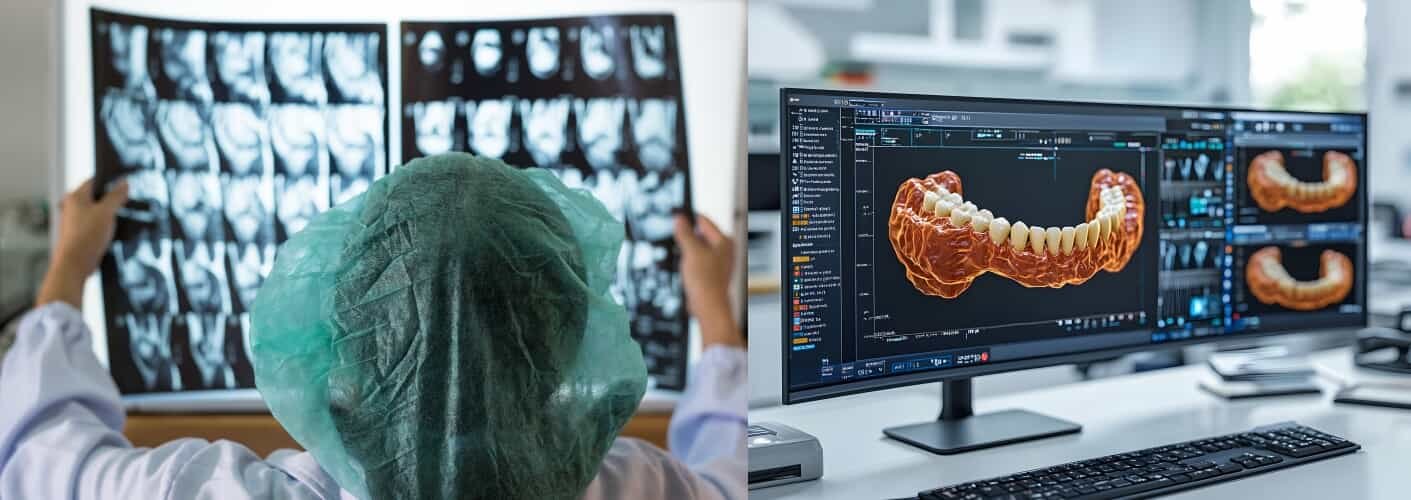
Traditional Film Radiography vs. Digital Imaging in Dentistry
Traditional film radiography has been a trusted method for decades but has several limitations. Film processing involves chemical development, a process that is both time-consuming and environmentally harmful.
Additionally, film images can degrade over time, making long-term storage and retrieval a cumbersome process. Dental professionals often face the challenge of maintaining large physical storage spaces for film records.
In contrast, digital imaging in dentistry offers numerous advantages. Phosphor plate scanners provide instant digital processing, eliminating the need for chemical development and reducing patient wait times. The resulting images provide high resolution and allow users to enhance, adjust, and store them electronically, ensuring accuracy and efficiency.
Digital records occupy no physical space and are easily retrievable, streamlining the workflow of any dental practice. Moreover, digital imaging is eco-friendly. It eliminates the need for hazardous chemicals, reducing the environmental impact of dental radiography.
From a financial perspective, traditional film radiography requires continuous expenses for:
- Film
- Chemicals
- Storage
Over time, these costs accumulate, making it an expensive option in the long run. Phosphor plate scanners need a higher initial investment. However, they have lower ongoing costs because users can reuse the plates. This makes them a cost-effective solution for modern dental practices looking to enhance efficiency and patient care.
More In-Depth Examples of How Phosphor Plate Scanners Can Help Your Dental Practice
Transitioning to phosphor plate scanners can revolutionize a dental practice’s efficiency and effectiveness. By eliminating chemical processing, practices can reduce imaging turnaround times, allowing for quicker diagnostics and more streamlined patient treatment plans.
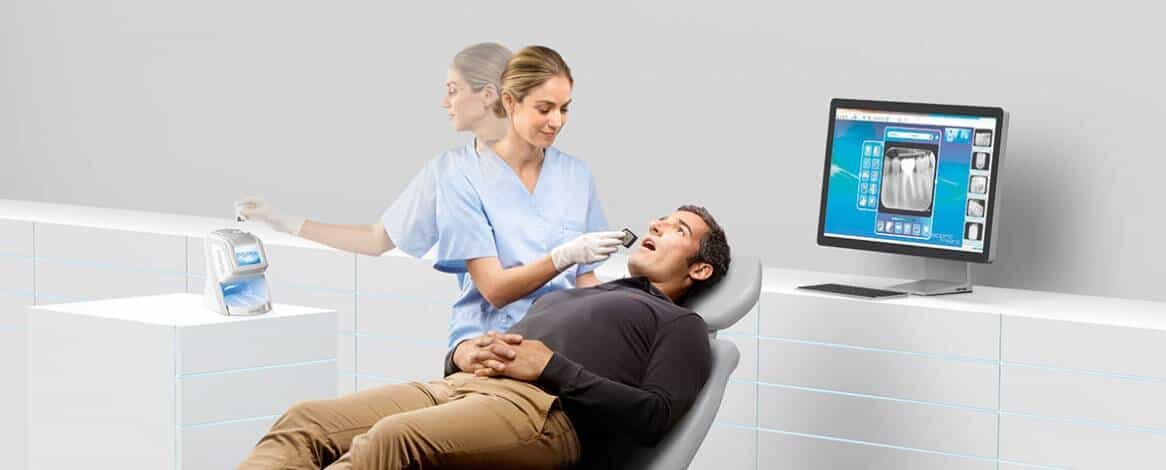
High-resolution digital images provide better visualization of dental structures. They enable earlier detection of issues such as:
- Cavities
- Root infections
- Bone loss
Additionally, digital storage simplifies record-keeping, making it easier for dentists to access patient history and share images with specialists when necessary. Using phosphor plate scanners improves workflow and the patient experience. They reduce wait times and provide clearer treatment plans with high-quality digital images.
Adopting this advanced dental imaging technology allows dental professionals to:
- Optimize their operations
- Reduce overhead costs
- Elevate the overall standard of care within their practice
Eliminating chemical processing speeds up workflow, allowing for faster diagnostics and treatment planning.
Digital imaging enhances the ability to detect early-stage dental issues more clearly, improving patient outcomes.
Additionally, integrating digital imaging in dentistry allows for easier image storage, retrieval, and sharing, ensuring seamless collaboration among dental professionals.
By adopting this advanced dental imaging technology, practices can:
- Reduce costs
- Streamline operations
- Elevate their standard of care
Top Phosphor Plate Scanners in 2025
Dental professionals rely on high-quality phosphor plate scanners to ensure accurate and efficient imaging. Here are some of the best options in 2025.
1. Dürr VistaScan Ultra View ($6,882.00)
Experts widely recognize this advanced phosphor plate scanner for its exceptional high-resolution imaging capabilities, which ensure precise and accurate diagnostics. Its fast processing speed helps dental professionals obtain and study detailed images right away, improving efficiency and patient flow.
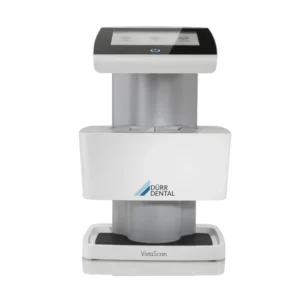
The scanner is small but powerful. It would be a great addition to any dental practice. It fits into current workflows and saves space, and it improves overall imaging performance.
- Key features: High-resolution touchscreen, fast processing speed, and compact design
- Benefits: Provides exceptional image clarity and ideal for advanced diagnostics
2. Planmeca ProScanner 2.0 ($2,299.00)
Engineers designed this phosphor plate scanner to provide rapid and highly reliable imaging. It caters specifically to the demands of busy dental practices. Its strong build ensures it lasts a long time. Its fast scanning technology also cuts down wait times for doctors and patients.
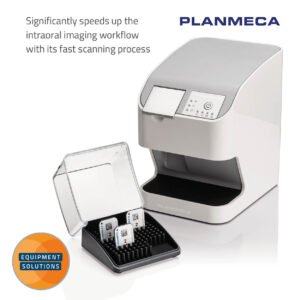
The device integrates into existing workflows, enhancing efficiency with minimal training required. Additionally, its intuitive user interface makes it easy to operate. It enables dental professionals to adapt and optimize their diagnostic capabilities quickly. Precision, speed, and ease of use make this scanner a valuable asset in any modern dental practice.
- Key features: User-friendly interface, durable construction, and quick scanning capabilities
- Benefits: Suitable for busy dental practices needing reliable performance
3. Dürr VistaScan Mini View 2.0 ($5,655.00)
This phosphor plate scanner provides exceptional image quality while maintaining a compact and space-saving design. These qualities make it ideal for any dental practice.
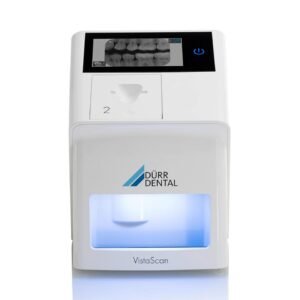
The intuitive touchscreen interface enhances usability, allowing for:
- Effortless navigation
- Precise image modifications
- Quick access to various imaging settings
Dental professionals can quickly scan and process images, reducing patient wait times and improving diagnostic efficiency. The enhanced image resolution captures even the smallest details, improving the detection of dental anomalies.
Furthermore, seamless integration with existing practice management software allows for smooth workflow transitions. This scanner’s mix of speed, accuracy, and convenience makes it an essential tool for today’s dental clinics.
- Key features: High-resolution display, intuitive software, and quick scan time
- Benefits: Efficient and easy to integrate into any dental practice
4. Dürr VistaScan Mini Easy 2.0 ($4,995.00)
This phosphor plate scanner is an excellent choice for small to mid-sized dental practices. It offers a good mix of efficiency, affordability, and performance. Its compact size allows for easy placement in limited office spaces while still delivering high-quality imaging capabilities.
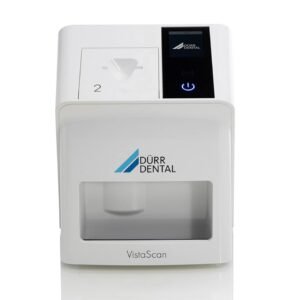
The user-friendly interface simplifies operations. It ensures practitioners can quickly capture, process, and analyze images.
This scanner uses high-resolution images and fast processing speeds. It improves diagnostic accuracy, enabling dentists to identify problems more precisely. Its seamless integration with existing practice management systems also ensures a smooth transition to digital imaging, reducing workflow disruptions and improving overall efficiency.
The scanner is affordable, making it a suitable option for practices that want to upgrade their technology without incurring significant expenses.
- Key features: Compact and space-saving, simple operation, excellent image quality
- Benefits: Ideal for small and mid-sized practices looking for affordability and efficiency
5. Air Techniques ScanX Duo Touch ($6,999.00)
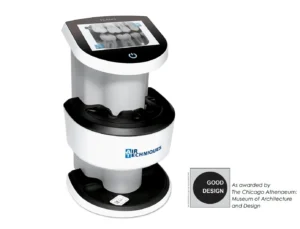
Designers created this phosphor plate scanner for busy dental practices. It helps manage a high number of patients efficiently. Its advanced dual-slot design allows for:
- Simultaneous scanning of multiple plates
- Effectively minimizing processing times
- Increasing overall productivity
Integrating a highly intuitive touchscreen interface enhances user interaction, enabling:
- Smooth navigation
- Quick adjustments
- Seamless workflow management
Ultimately, it optimizes the diagnostic process while reducing downtime in a fast-paced clinical environment.
- Key features: Dual slots for simultaneous scanning and touchscreen interface
- Benefits: Enhances productivity and speeds up the imaging process
6. Air Techniques ScanX Swift View 2.0 ($5,226.00)
People recognize this phosphor plate scanner for its high-speed image processing and exceptional clarity. This ensures that every scan captures the finest details for precise diagnostics. It supports all sizes of intraoral plates, making it a versatile choice for various dental imaging needs, including bitewings and periapicals.
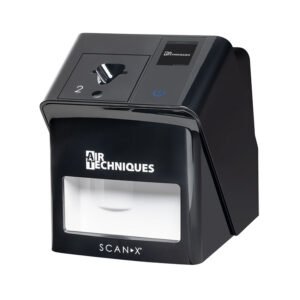
Its compact, ergonomic design and ultra-fast scan speeds enhance workflow efficiency while conserving valuable space. This makes it an essential tool for modern dental practices aiming for optimal performance and streamlined operations.
- Key features: Compact design, fast scan speeds, supports all intraoral sizes
- Benefits: A versatile scanner perfect for practices of all sizes
Elevate Your Practice With Phosphor Plate Scanners
Upgrading to the Top 10 phosphor plate scanners is a wise choice for dental practices. It helps improve diagnostic accuracy, streamline workflow, and enhance patient experience.
Phosphor scanners have many benefits. They provide better image quality and faster processing times.
They also save money over time compared to traditional film radiography. At Universa Dental, every dental professional should have access to good, strong, and dependable equipment. We aim to help practices find the best dental imaging technology at competitive prices. Please browse our selection of dental equipment products, including Phosphor Plates, and invest in your practice’s future today.
